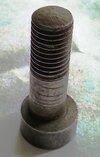Oh Dear!  I stand corrected but did the factory ever use/supply the two to the left of your photograph? Similar question with the nylock nut.. I have alsways assumed that they were not available back in the 40s and 50s.
I stand corrected but did the factory ever use/supply the two to the left of your photograph? Similar question with the nylock nut.. I have alsways assumed that they were not available back in the 40s and 50s.
You are using an out of date browser. It may not display this or other websites correctly.
You should upgrade or use an alternative browser.
You should upgrade or use an alternative browser.
Wheel Building
- Thread starter Cyborg
- Start date
I have seen quite a few of the bolts on the left with the double flats. I purchased a "lot" of used stuff probably 20 years ago that came mostly out of the Detroit area and there were about 6 or 8 complete but old and rusty wheels in there. many of those bolts. I think the ones in the middle like the nylocks are a "well after the factory" addition to the parts supply chain! As for the other nuts I would go mostly with the ones with the red locking rings as the most common, next would be the ones with the little split integral collars.Oh Dear!I stand corrected but did the factory ever use/supply the two to the left of your photograph? Similar question with the nylock nut.. I have alsways assumed that they were not available back in the 40s and 50s.
That is the type I have seen on nearly every unmolested Vin I have worked on.
Those split type self locking nuts are from the aircraft game.........Used on many British a/c from back in the day........They never use any kind of nyloc nuts on or around a/c engines because the nylon insert will melt from the heat........ Just a bit of useless info for all you tech heads.
Were the original nuts, with the slit locking tops, called Simmonds nuts?
But would I ever think about using these "safety" nuts in this aplication ? Definitely not, never ever use nylocs on all of my bikes. Instead a bit of well selected Loctite on threads will do this job a lot safer plus seals the thread from rusting within. It will be effective for several turns on the nut, unlike nylocs when the bolt is a bit short - or the nyloc was used a number of times. When having stainless fasteners be sure to apply antiseize - or Loctite.
Vic
Vic
Mine has alloy brake plates back and front and all have shims between the bearings and the plates for clearance
My experience with wheel hubs is that there are variences with the spoke flanges and the drum casting wall thicknesses........You should be able to build up the complete hub including the drums, flanges, the alloy hub all the bolts and nuts fully and then install the spokes through the flanges to assemble the rim........Always start witha good inspection of the bearing pockets........loose bearings can be secured with green loctite, but if any side play is detected, the hub should be replaced........On complete restorations it is very common for me to simply replace both front and rear hubs with new ones, this is far more cost effective than hoping a cheaper repair will last.
Yes, invented by Sir Oliver Simmonds. The Spares List spells it incorrectly. All original ones I've seen have a red fibre? insert. I've got a gross of the double anchor nuts, 588 I bought at an airframe parts supplier in the 70's. The nuts with the split in them are Aerotite ones. As far as I know never used on Vincents, but handy on slightly longer studs holding the timing gear steady plate. The conkers judges don't see them and it sure beats punch locking. Just to clarify, Simmonds nuts were not slit, original Aerotite ones were. Simmonds nuts are 98, 499 and 588.Were the original nuts, with the slit locking tops, called Simmonds nuts?
Last edited:

